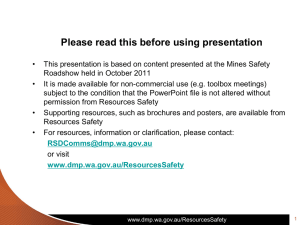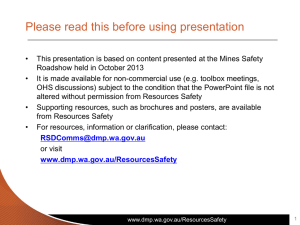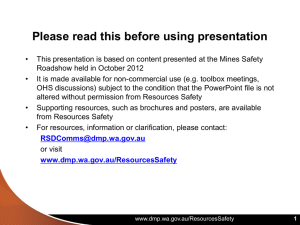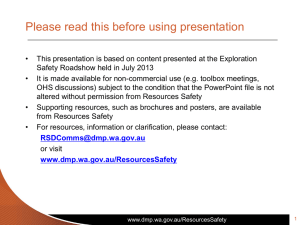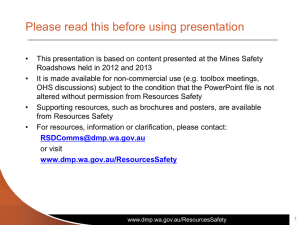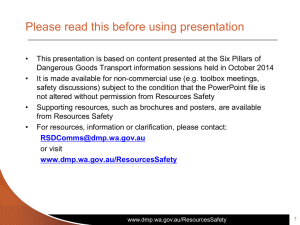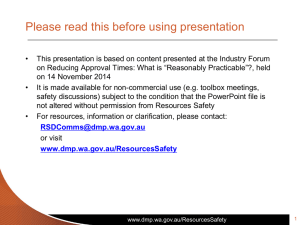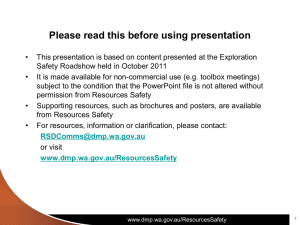Safety performance in the Western Australian mineral industry 2009
advertisement
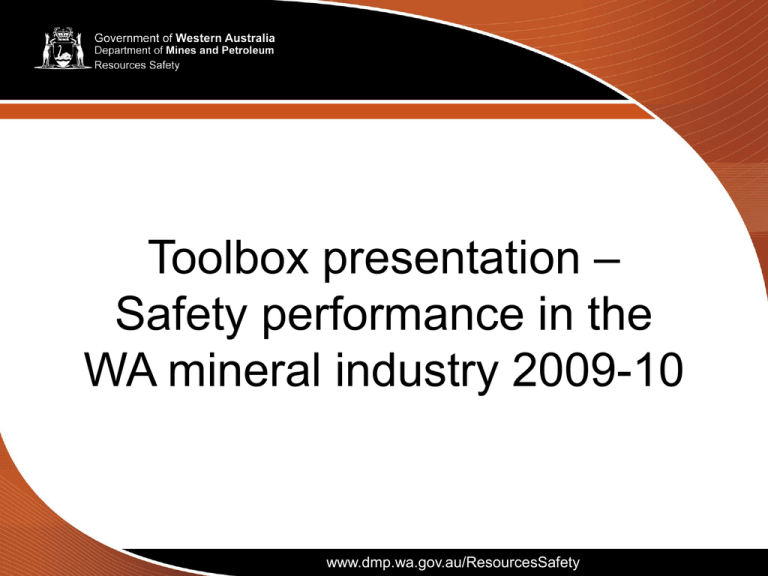
Toolbox presentation – Safety performance in the WA mineral industry 2009-10 www.dmp.wa.gov.au/ResourcesSafety Please read this before using the presentation • • • • The charts and tables in this presentation were prepared by Resources Safety from data submitted by mining operations throughout Western Australia as required by section 76 of the Mines Safety and Inspection Act 1994. Note that, apart from slides 8 and 12, exploration data are not included in the charts. This presentation is made available for non-commercial use (e.g. toolbox meetings) subject to the condition that the content is not altered without permission from Resources Safety Supporting resources, such as brochures and posters, are available from Resources Safety For resources, information or clarification, please contact: – ResourcesSafety@dmp.wa.gov.au or visit – www.dmp.wa.gov.au/ResourcesSafety www.dmp.wa.gov.au/ResourcesSafety Definitions • • • • Lost time injury (LTI): A work injury that results in an absence from work for at least one full day or shift any time after the day or shift on which the injury occurred Serious injury: A lost time injury that results in the injured person being disabled for a period of two weeks or more Minor injury: A lost time injury that results in the injured person being disabled for a period of less than two weeks Disabling injury (DI): Work injury (not LTI) that results in injured person being unable to perform his or her ordinary occupation (regular job) any time after the day or shift on which the injury occurred, regardless of whether or not the person is rostered to work, and where alternative or light duties are performed or hours are restricted www.dmp.wa.gov.au/ResourcesSafety Definitions cont. • • • • • • • • Incidence rate: The number of lost time injuries per 1000 employees for a 12-month period Fatal injury incidence rate: The number of fatal injuries per 1000 employees for a 12-month period Lost time injury frequency rate: The number of lost time injuries per million hours worked Duration rate: The average number of workdays lost per injury Injury index: The number of workdays lost per million hours worked Serious injury frequency rate: The number of serious injuries per million hours worked Metalliferous mines: All mines other than coal mines are classed as metalliferous mines NOC: Not otherwise classified www.dmp.wa.gov.au/ResourcesSafety Mining statistics for 2009-10 • Average workforce of 68,778 employees (slight decrease of 3% on previous year, when there were 70,567 employees) • Three fatal accidents – one underground at a gold mine – one underground at a nickel mine – one on the surface at a bauxite and alumina operation • 422 lost time injuries (25 more than in 2008-09) • Overall LTI duration rate improved by 11% (fell from 21.9 in 2008-09 to 19.4 in 2009-10) • Overall LTI frequency rate deteriorated by 11% (rose from 2.8 to 3.1) • Overall injury index remained unchanged at 61 www.dmp.wa.gov.au/ResourcesSafety Mining statistics for 2009-10 cont. • 340 serious LTIs (24 more than in 2008-09) • Overall serious LTI frequency rate deteriorated by 14% (rose from 2.2 to 2.5) • Iron ore sector LTI frequency rate improved significantly by 40% (fell from 2.5 to 1.5) • Bauxite and alumina sector LTI frequency rate deteriorated significantly by 57% (rose from 2.8 to 4.4) • Gold sector LTI frequency rate deteriorated significantly by 63% (rose from 1.9 to 3.1) • Nickel sector LTI frequency rate deteriorated significantly by 33% (rose from 2.4 to 3.2) www.dmp.wa.gov.au/ResourcesSafety Mining statistics for 2009-10 cont. • 673 disabling injuries (65 more than in 2008-09) • Overall DI frequency rate deteriorated by 16% (rose from 4.3 to 5.0) www.dmp.wa.gov.au/ResourcesSafety Exploration statistics for 2009-10 • Average workforce of 2,807 employees (increase of 19% on previous year when there were 2,350) • 38 LTIs (6 more than in 2008-09) • Overall LTIFR deteriorated slightly by 3% (rose from 6.5 to 6.7) www.dmp.wa.gov.au/ResourcesSafety Fatal accidents 2009-10 • A service crewman employed at an underground gold mine was fatally injured when he fell through an ore pass grizzly onto the muck pile 38 metres below. He had been attempting to cover the grizzly to prevent dust coming out of the ore pass system during tipping operations from higher levels in the mine. His body was discovered in the early hours of the morning. www.dmp.wa.gov.au/ResourcesSafety Fatal accidents 2009-10 cont. • An employee of a high-pressure water de-scaling contractor working at an alumina refinery was fatally injured in the early hours of the morning when he fell at least 25 metres inside a process vessel at height and struck the ground. The vessel comprised two separate but adjoining chambers. The worker apparently fell through an open manhole into the lower chamber of the vessel and then to the ground via a discharge chute. www.dmp.wa.gov.au/ResourcesSafety Fatal accidents 2009-10 cont. • An underground loader operator employed at an underground nickel mine was fatally injured when he drove a load-haul-dump (LHD) machine into an open stope void and fell about 24 metres. www.dmp.wa.gov.au/ResourcesSafety Injuries by mineral mined during 2009-10 www.dmp.wa.gov.au/ResourcesSafety Nature of injury www.dmp.wa.gov.au/ResourcesSafety Part of body injured www.dmp.wa.gov.au/ResourcesSafety Location of accident www.dmp.wa.gov.au/ResourcesSafety Type of accident www.dmp.wa.gov.au/ResourcesSafety Fatal injury incidence rate www.dmp.wa.gov.au/ResourcesSafety Comparison of injury index and compensation premium rate www.dmp.wa.gov.au/ResourcesSafety Lost time injury frequency rate by location www.dmp.wa.gov.au/ResourcesSafety Lost time injury frequency rate by severity www.dmp.wa.gov.au/ResourcesSafety
